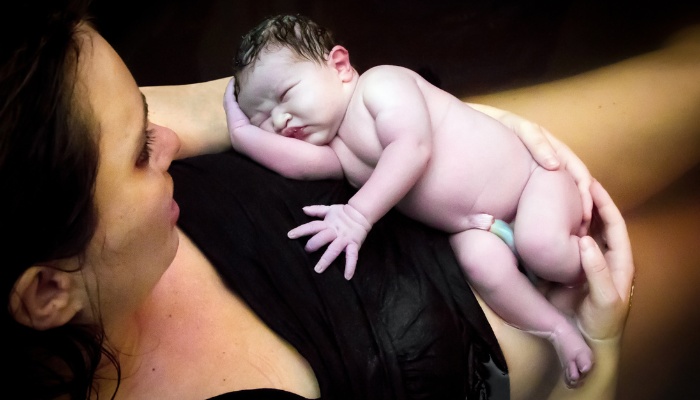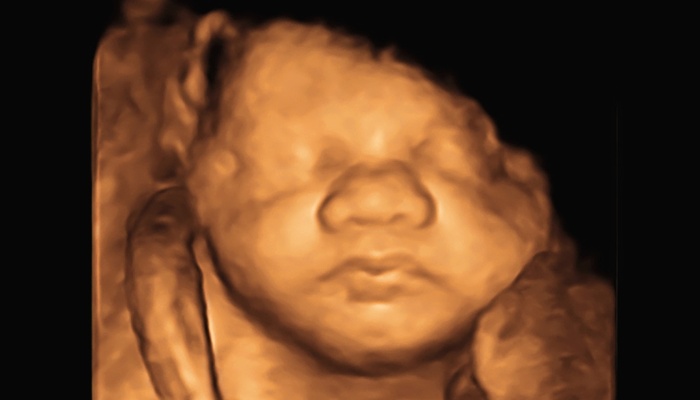It is common for noses to appear distorted on a 3D ultrasound, and the resulting image is not always an accurate depiction of the baby’s actual appearance.
The distortion is due to factors like the positioning and movement of the fetus, variations in amniotic fluid density, and limitations in ultrasound technology.
According to ScienceDirect:
“If the structure being imaged moves during the data collection, the final rendered set will be distorted. This is particularly a problem with an active fetus and produces bizarrely distorted three-dimensional images.”
Parents expecting to see a clear, high-quality image of the developing baby are often disappointed.
If you were shocked when you saw what appeared to be a large, flat nose on your 3D ultrasound, you’re not alone. I felt the same way.
Nose distortion on a 3D ultrasound is a common occurrence, but rest assured knowing that the oversized nose is an inaccurate rendering, and your baby will likely be born with a perfectly adorable (and normal) nose.
Table of Contents
3D Ultrasounds: Baby Imaging and Distortion
3D ultrasounds are a great tool for diagnostic purposes, but when it comes to evaluating looks, they leave a lot to be desired.
Is It Normal for Baby Nose To Look Big on 3D Ultrasound?
Yes, it’s normal for a baby’s nose to look big on a 3D ultrasound due to faulty sound waves, bad angles, or the baby just being squished.
In rare cases, a large or flattened nose can indicate genetic abnormalities.
If you’re concerned about your ultrasound pictures, it’s best to consult with your sonographer and doctor.
Nose on 3D Ultrasound vs. Baby Nose at Birth
While your baby’s nose could look large, flattened, or malformed in an ultrasound, this will not likely be the case at birth.
Ultrasound pictures of big noses are typically the result of environmental factors and are not accurate representations of what the baby’s nose will look like outside of the womb.
By the time your baby is born, their nose is likely to be fully developed and properly formed.
If your child is born with a nose deformity, corrective treatments may be necessary so that your child can breathe in the early months of their life.

How 3D Ultrasounds Work
Ultrasounds use sound waves sent by a transducer to create an image.
These sound waves bounce off of the surfaces of the baby’s body and the mother’s uterus to evaluate the depth, height, and width of the images.
These images are then combined to create one 3D rendering of what the baby looks like inside the womb.
Your baby’s face has small, smooth features that sound waves have trouble with.
To compensate, the machine may broaden or stretch certain features in order to produce the image.
3D Ultrasound Distortion
Most of the time, ultrasound image distortions are caused by the sound waves being interrupted by the baby’s movement.
However, there are several reasons why a 3D ultrasound might be inaccurate.
- Ultrasound technology: The 3D technology relies on the reflection of sound waves off tissues and structures in the body. However, it’s not always possible to get a perfectly clear and detailed image, especially when it comes to small, intricate structures like facial features.
- Positioning of the fetus: The position of the fetus in the womb can significantly affect the quality of the 3D image. If the fetus is in an awkward position or has its face turned away from the ultrasound transducer, it can be challenging to capture a clear image of the facial features.
- Amniotic fluid and tissue density: The density of the amniotic fluid and surrounding tissues can affect the clarity of the ultrasound image. Sometimes, variations in fluid density or the presence of other structures in the field of view can create distortions.
- Mother’s body type: The mother’s size and shape can influence the quality of the ultrasound images. A larger woman might result in a less clear image due to the increased tissue depth that the ultrasound waves must penetrate.
- Fetal movement: Fetal movement during the ultrasound scan can also impact the clarity of the images. If the fetus is moving around, it can be difficult to capture a still image of the face.
- Technician skill and experience: The skill and experience of the ultrasound technician can play a significant role in obtaining clear images. An experienced technician may be better able to adjust the settings and angles to get the best possible view.
- Equipment quality: The quality and capability of the ultrasound machine itself can influence the clarity of the images. Higher-end machines with advanced imaging technology are more likely to produce clearer images.
- No room: Your baby is squished inside your uterus, and many times the face is pressed against the uterine wall.
- Baby is still growing: Your baby may still be developing body fat, which can make the facial structure look bony.
Common Distorted Features With 3D Ultrasound
There is consistency in what features are skewed and how badly they are distorted. In most cases, a baby’s nose, lips, or facial shape will not be accurately depicted.
This is typically due to how the baby is positioned in the uterus, how much they’re moving, and the amount of amniotic fluid surrounding them.
3D Ultrasound Safety
The American College of Obstetricians and Gynecologists (ACOG), the Food and Drug Administration (FDA), and the American Institute of Ultrasound in Medicine (AIUM) recommend the use of ultrasounds strictly for medical purposes by trained professionals.
This is due to inconsistent levels of training among employees at “keepsake ultrasound” facilities.
An improperly trained sonographer could cause unnecessary concern to the expecting parents if they think they see something abnormal, or they may miss an abnormality entirely.
Ultrasounds do not use radiation and are safe as part of routine prenatal care. Unofficial ultrasounds should not replace recommended sonogram visits with a qualified professional.
Newborn Baby After Birth

Many people develop expectations around birth and delivery from what they’ve seen on television.
However, this process is usually cleaned up and beautified for filming to make it more digestible for the audience.
In reality, birth is messy and unpredictable. When a baby is born, they do not come out spotless, glowing, and chunky.
Rather, their heads will be misshapen, and their features may be swollen and sometimes bruised from the pressure of the birth canal.
In addition, they will be covered in a white cheesy-looking protective layer, called vernix, and blood.
Beyond that, the baby may appear to have a short layer of fuzz all over their body called lanugo.
Lanugo is a type of body hair that helps the baby regulate temperature in the womb.
The earlier a baby is born, the more body hair they’re likely to have.
When Do Babies’ Looks Change?
Babies go through a lot of changes and growth in the first few months of life. By three months, your baby will look like a different baby entirely.
As the shock of birth subsides, swelling and bruising will fade. The vernix will be bathed away, and the baby’s head will return to normal shape within days or weeks from birth.
Baby’s hair and eyes will begin to change, if they’re meant to, by three months of age as well.
They will grow fuller and less wrinkly and spend less time curled up. Now they’ll be looking more like a baby and less like an alien.
When Do Babies’ Noses Change?
Pressure from the womb and birth can cause a baby’s nose to appear flat or wide. This is because the bridge of the baby’s nose is not fully formed at the time of birth.
The baby’s nasal passage isn’t fully developed until a few weeks or months after birth.
This isn’t the end of its growth though, and in fact, your child’s nose will change until the time they hit puberty.
How To Improve Baby Nose Shape
It’s normal for parents to be concerned about their child’s appearance, but there are risks associated with tampering with a child’s physical development.
Simply put, there is no safe way to improve your baby’s nose shape.
Some parents try nose pinching, and others buy nose shapers online, but doing so can cause unintended harm.
The cartilage or septum of the nose can be damaged by such pressure.
Related Questions:
How Many 3D Ultrasounds Can You Get?
The quantity of 3D ultrasounds that can be scheduled is dependent on where you go to get them.
In a hospital setting, 3D ultrasounds are typically only used in cases in which the doctor deems them necessary.
Otherwise, they are considered to be elective procedures and are typically not covered by insurance.
Current guidelines from several authorities state that ultrasounds should be avoided unless medically necessary.
When Can a 3D Ultrasound Detect Gender?
Given the right conditions, a 3D ultrasound can detect gender around 14-16 weeks.
However, this type of appointment is only available at independent clinics.
Healthcare providers will typically do an anatomy scan between 18 and 22 weeks at which point they can reveal the gender or will offer additional methods of testing.
Charley is a mother of three with a passion for raising good humans. With her children in tow, she studies English and has made a career creating content about motherhood. In her free time, she enjoys traveling within the states to kayak, camp, and hike.

